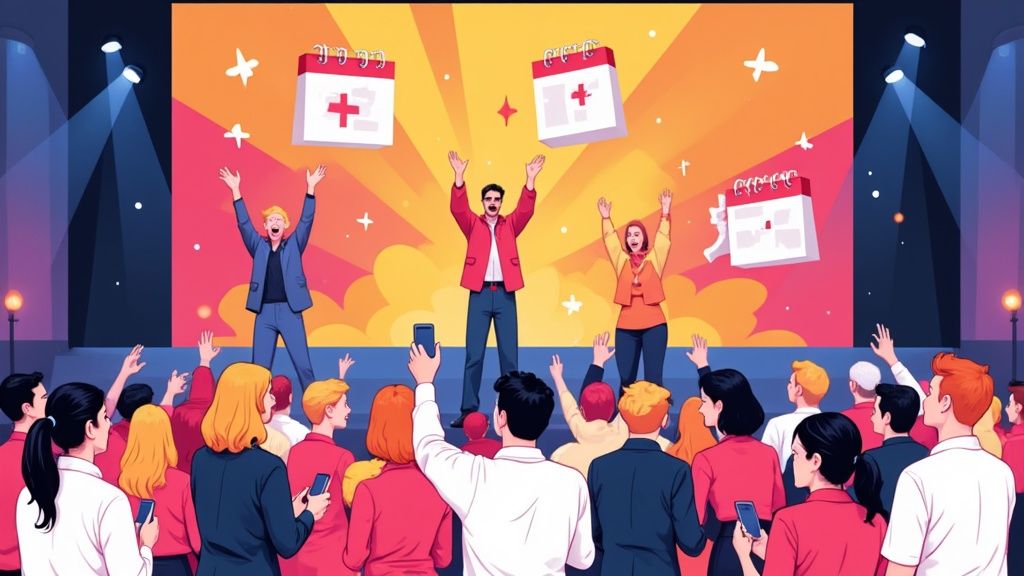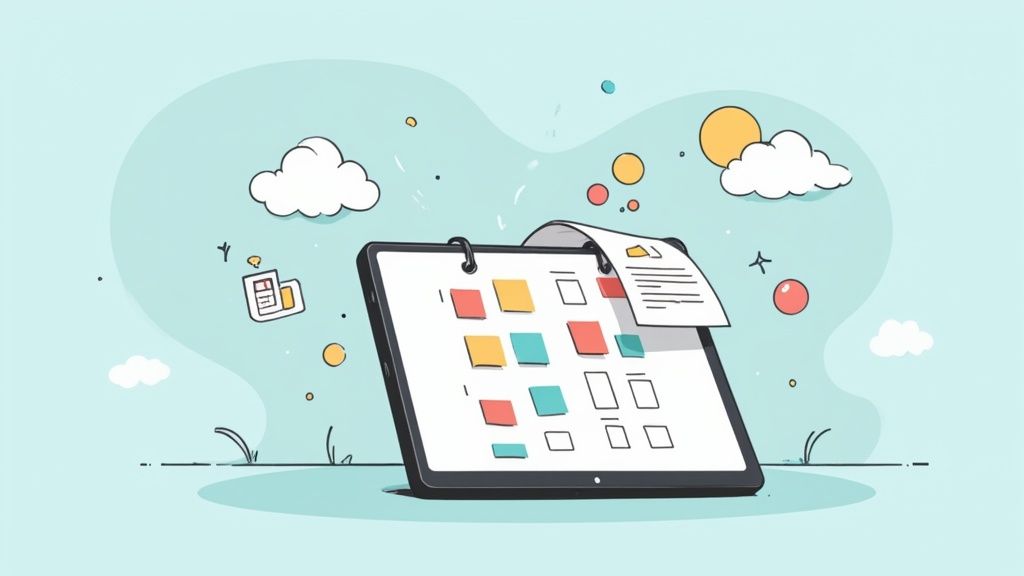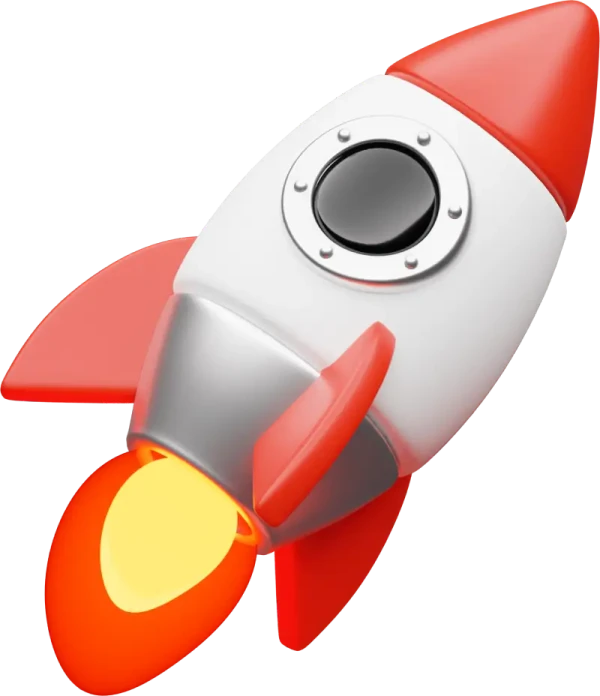If you want to pack your event, you need more than just a great idea. You need a smart, modern game plan that gets people excited to show up. An empty room - whether it's a physical conference hall or a Zoom meeting - is every event organizer's worst nightmare.
The good news? You can turn lackluster sign-ups into a sold-out event. It’s all about blending smart digital tactics with tried-and-true marketing to build unstoppable momentum. The key is to get the fundamentals right.
Your Modern Playbook for Boosting Event Turnout
Let's cut to the chase. To really move the needle on attendance, you need to focus on three things: expanding your reach, personalizing your communication, and making the entire attendee journey seamless, from the moment they hear about your event to the moment they join.
This isn't about just throwing spaghetti at the wall. It’s about being strategic. The data backs this up.
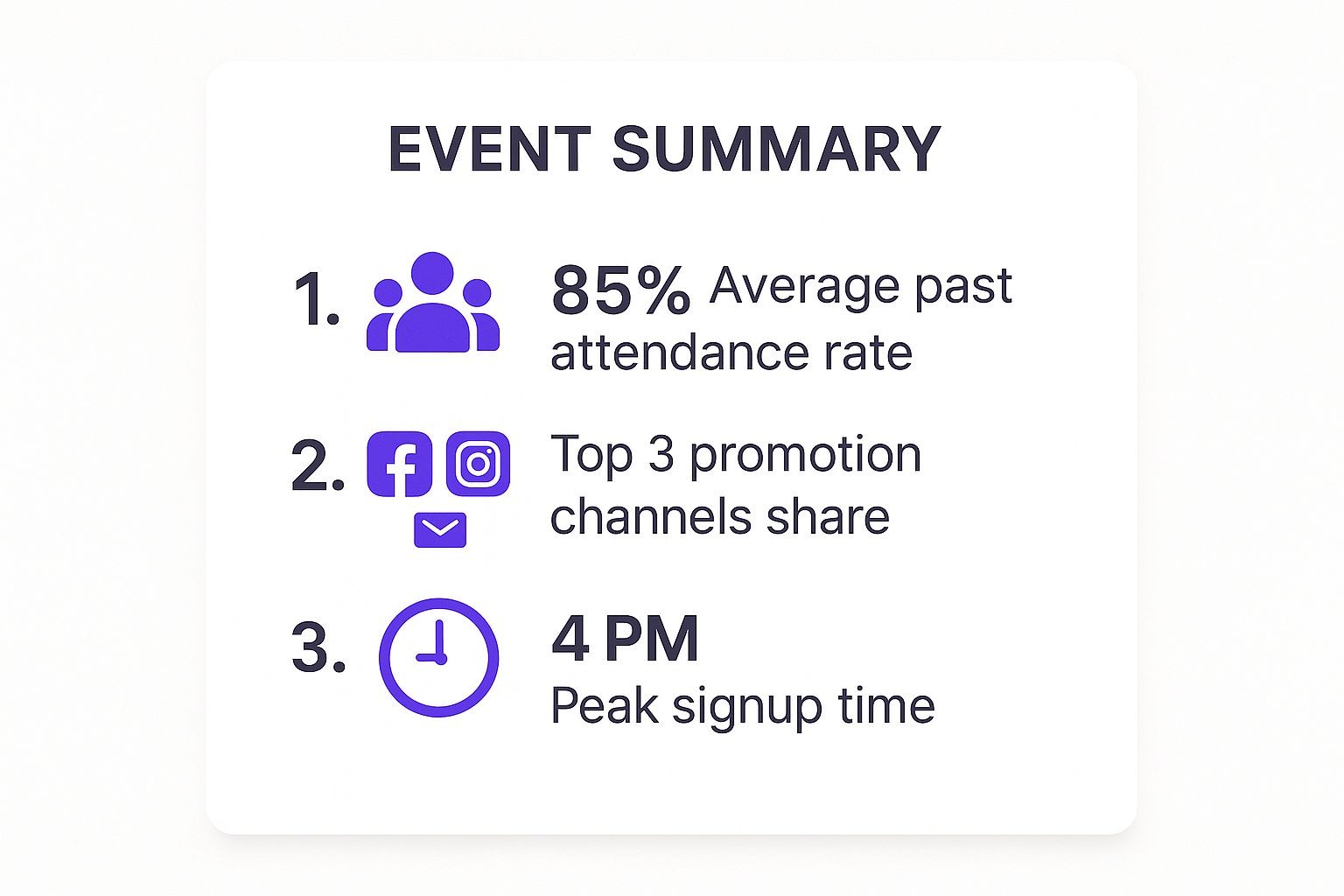
As you can see, a huge chunk of your potential audience can be snagged through social media, especially with a well-timed push. It’s a clear sign that where and when you promote matters. A lot.
The Foundational Strategies That Actually Work
To build a solid foundation, you need to nail your promotion. Digging into effective social media marketing strategies is a great starting point. Forget mass messaging - it just doesn't work anymore. The real magic happens when you create content that speaks directly to the problems and passions of your ideal attendee.
The most successful events don't just happen. They are the result of a deliberate, data-informed strategy that prioritizes the attendee experience at every single touchpoint.
This guide will break down the essential pieces you need to boost your numbers. We’re talking about practical, real-world strategies that successful organizers are using right now.
Specifically, we'll cover:
- Going Hybrid & Virtual: Learn how to tap into a global audience by offering flexible ways to attend. Why limit yourself to just one city?
- Targeted Outreach: Discover how to segment your audience and send personalized invites that feel exclusive and valuable, which is a surefire way to drive up registrations.
- High-Converting Pages: Build an event page that does more than just inform - it convinces. We'll show you how to use tools like Add to Calendar buttons to dramatically reduce no-shows.
- Smart Budgeting: Learn where to put your money to get the best bang for your buck, from securing better speakers to enhancing the overall experience.
To give you a clearer picture, these strategies all boil down to a few core pillars. Think of them as your non-negotiables for event success.
Core Pillars for Increasing Event Attendance
The table below summarizes the essential strategies that have the biggest impact on boosting event participation. If you get these right, you're already ahead of the game.
| Strategy Pillar | Key Action | Expected Outcome |
|---|---|---|
| Visibility & Reach | Promote across multiple relevant channels with targeted ads. | Increased brand awareness and a wider pool of potential attendees. |
| Compelling Value | Clearly articulate "what's in it for them" with strong copy. | Higher interest and a greater desire to register. |
| Frictionless Registration | Simplify the sign-up process and add a one-click calendar button. | Reduced drop-off rates and fewer no-shows. |
| Consistent Engagement | Send reminder emails and valuable pre-event content. | Maintained excitement and a stronger community feel. |
By mastering these pillars, you're not just hoping for a good turnout - you're engineering it. This approach provides a clear, repeatable roadmap for consistently increasing your event attendance.
Expand Your Audience With Virtual And Hybrid Formats
The days of geographical barriers dictating your event's reach are over. The very definition of "attending" has changed, and one of the most powerful moves you can make is to embrace a virtual or hybrid format. This isn't just about sticking a camera in the back of the room; it's about building a parallel, engaging digital experience from the ground up.
By offering a virtual component, you immediately throw the doors open to a global audience. Think about all the people who couldn't justify the travel, the hotel costs, or taking that much time off work. Now they can be there.
This isn't just a hunch - it's a massive market shift. The virtual event market is expected to balloon to $236.69 billion by 2025. The numbers show this growth is fueled by real engagement. Virtual events often hit 60–70% engagement rates, with people spending 27% more time with online content than they do in person. Plus, organizers can cut costs by an average of 75% and boost lead capture by up to 30%. You can dig into more of these stats over at remo.co.
Designing A Compelling Virtual Experience
To make this work, you have to design an online experience that feels valuable, not like a second-best option. The main reason people show up for virtual events is knowledge. A full 80% of participants are there for educational content.
That means your content needs to be the main event. You can deliver real, tangible value with things like:
- Interactive Workshops: Use breakout rooms for small-group discussions and hands-on activities.
- Expert Q&A Sessions: Go beyond a simple presentation and let your audience interact directly with speakers.
- On-Demand Content: Make recordings and resources available after the fact so people can revisit key takeaways.
A successful hybrid event needs dedicated production to ensure the virtual audience feels just as included as the people in the room.
A hybrid event isn't one event with two audiences. It's two distinct experiences - one physical, one digital - running in parallel and designed with equal care and intention.
The Technology and ROI Advantage
The financial upside of going virtual or hybrid is huge. When you cut back on huge expenses like the venue, catering, and travel, you can put that money toward things that actually move the needle on attendance.
Imagine what you could do with that freed-up budget:
- Book A-List Speakers: You can suddenly afford industry titans who were previously out of reach because of travel schedules or high fees. Their name alone can be a massive draw.
- Invest in Better Tech: A solid webinar platform with live polls, chat, and virtual networking lounges is critical for keeping an online audience hooked.
- Double Down on Marketing: More budget for targeted ads and promotion means you can reach a much wider - and more qualified - audience.
This shift genuinely pays off. An incredible 81% of companies say they get a higher return on investment from virtual events than from their in-person ones. By dropping the physical limitations and focusing on a top-notch digital experience, you're creating a model that is more accessible, scalable, and profitable. It’s a natural path to higher attendance.
Master Personalized Outreach and Targeted Marketing
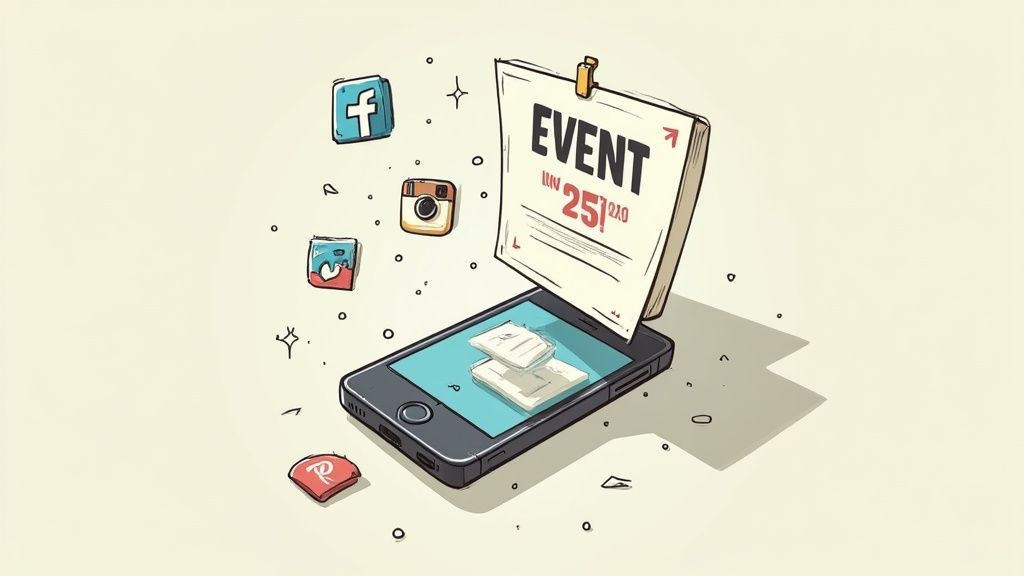
Let's be honest: generic email blasts are the quickest way to get your event invitation sent straight to the trash. If you really want to boost attendance, you have to stop shouting into the void and start having meaningful conversations, just at a larger scale.
This is a mindset shift from mass marketing to precise, personalized outreach. It's about making each person feel like they were invited for a reason.
Your best friend in this mission? Your Customer Relationship Management (CRM) system. It’s so much more than a digital address book - it's a goldmine of data telling you exactly who is most likely to care about your event. By looking at past interactions, you can pinpoint your ideal attendees and write messages that speak directly to what they care about.
This isn't just a hunch; it's a proven strategy. When you use your CRM to invite specific contacts, turnout improves substantially. The trick is to ditch the one-size-fits-all campaigns and explain why that person was invited. It creates a sense of exclusivity that’s hard to ignore.
Segment Your Audience For Maximum Impact
Segmentation is where personalization gets real. Instead of one message blasted to everyone, you create different messages for different groups. It's the secret to making sure your communication always feels relevant.
Think about a professional tech organization hosting its annual conference. They could slice their email list like this:
- Past Attendees: Send them an exclusive "welcome back" discount as a thank you for their loyalty.
- New Members: Position the event as the perfect opportunity to dive in, network, and get to know the community.
- C-Suite Executives: Focus on the high-level strategy sessions and exclusive networking dinners.
- Developers & Engineers: Shout about the deep-dive technical workshops and hands-on labs.
See the difference? This level of detail makes people feel seen and understood, not just marketed to. The message lands because it connects directly with their job, their interests, and their goals.
The goal of segmentation isn't just to sell a ticket; it's to start a relevant conversation. When you show someone you understand what they care about, they are far more likely to listen to what you have to say.
Amplify Your Message Across Multiple Channels
Once you've got your personalized messages ready, it's time to turn up the volume. A multi-channel strategy is key to making sure your invitation is seen in more than one place, reinforcing its importance. Your targeted emails are the foundation, but you need to build on them.
Get on social media and start creating some buzz with speaker announcements or behind-the-scenes content. Think about teaming up with industry influencers or even complementary companies who can promote the event to their own segmented audiences.
For a much deeper dive into crafting the perfect emails, check out our complete guide on using email marketing for events.
By creating this echo chamber of excitement, your event stops feeling like a single announcement and starts feeling like an unmissable industry moment. This powerful combo of personalization and amplification is the formula for driving registrations and guaranteeing a packed house.
Design An Irresistible And High-Converting Event Page
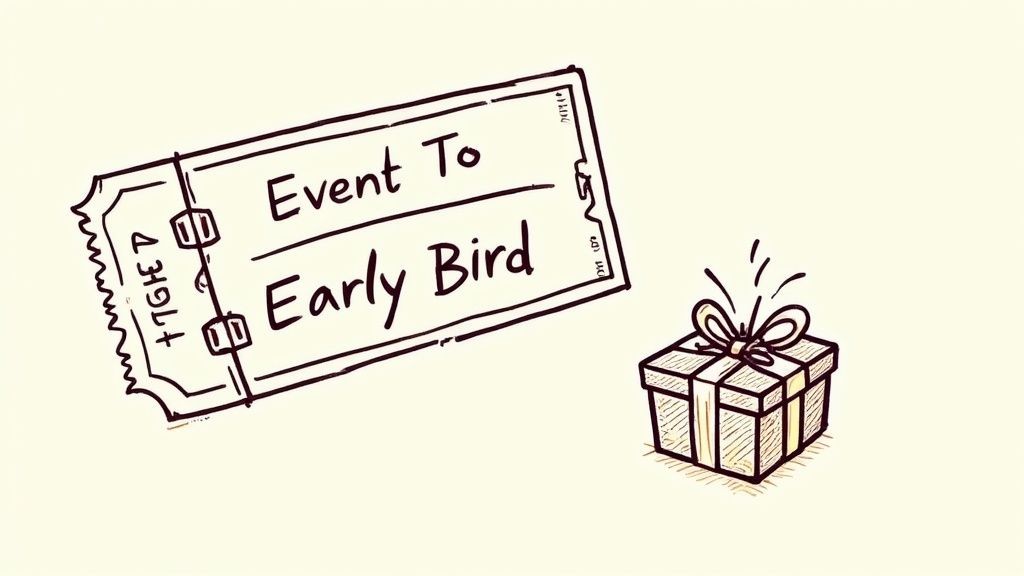
Think of your event landing page as more than just a digital flyer. It’s your single most important sales tool. Its one and only job? To turn a curious visitor into a registered attendee. If this page misses the mark, all your hard work promoting the event goes right down the drain.
A great page doesn't just list the date and time. It tells a story. It sells an experience. Every single element, from the headline right down to the color of your registration button, needs to be meticulously designed to guide that visitor toward one simple action: signing up.
Craft Compelling Copy That Sells The Value
The copy on your page has to immediately answer the one question on every potential attendee's mind: "What's in it for me?" Stop listing features and start selling benefits. Don't just say, "Featuring three keynote speakers." Instead, try something like, "Learn growth secrets from three industry titans who have built multi-million dollar businesses from the ground up."
Your focus should be on the transformation your attendees will walk away with. Will they pick up a game-changing new skill? Make career-defining connections? Finally solve a problem that's been nagging them for months? That's your unique value proposition. Make it the star of the show.
Your event page copy shouldn't just describe the event; it should make not attending feel like a missed opportunity. Frame the value in terms of career growth, new knowledge, or exclusive access.
To really get your page firing on all cylinders, implementing some solid conversion rate optimization tips is a must. You'd be surprised how small tweaks to your layout, copy, and call-to-action can lead to a huge jump in sign-ups.
Simplify The Journey From Visitor To Registrant
Friction is the absolute enemy of conversion. If your registration process is a complicated, confusing mess, people will bail - even if they're genuinely interested. Your goal is to make signing up completely effortless.
A clean, logical layout is non-negotiable. Use clear headings, short paragraphs, and plenty of white space to make the page easy to scan and digest.
Here are a few things your page absolutely needs for a frictionless experience:
- Mobile-First Design: A huge chunk of your audience will land on your page from their phone. It has to look fantastic and work perfectly on any device, no exceptions.
- Prominent Call-to-Action (CTA): Use bright, contrasting buttons with action-packed text. Think "Register Now" or "Save My Spot." Make them impossible to miss.
- Above-the-Fold Essentials: The most critical info - what, when, where, and why - needs to be visible the second the page loads, before anyone has to scroll.
Now, for the final piece of the puzzle: making sure they actually show up. The job isn't done once they hit "register." The confirmation page should immediately prompt them to add the event to their calendar. An Add to Calendar button is a deceptively simple tool that turns a fleeting intention into a locked-in calendar appointment, slashing your no-show rate.
This little feature is a critical link in the chain. If you're looking for some inspiration on how to structure your page, check out these excellent event landing page examples that do a great job of blending sharp design with powerful conversion tactics.
Where to Put Your Money (and Tech) for a Sold-Out Event
Let's be honest: sold-out events don't just happen by magic. They're almost always the result of smart planning and even smarter spending. If you really want to see your attendance numbers climb, you need to think critically about where your budget and your tech stack can give you the most bang for your buck.
The good news? It seems most of us are on the same page. Recent data shows a whopping 74% of event marketers are planning to open up their wallets and increase their event budgets. This tells us the industry gets it: you have to spend money to make money (or in our case, to fill seats). The real trick is knowing exactly where to direct those funds for the biggest impact.
Focus Your Spending on What Attendees Actually Care About
When you're figuring out how to spend that bigger budget, always, always start with the attendee experience. Pouring cash into marketing is great, but it’s a total waste if the event itself doesn't live up to the hype.
Here's where I've seen money make the biggest difference:
- Better Speakers: A high-profile speaker with real name recognition can be the single thing that pushes someone from "maybe" to "registered." Their expertise is a massive draw.
- A Killer Venue or Platform: For an in-person event, this could mean a more central location, better food, or just a cooler space. For virtual, it means a rock-solid, interactive platform that doesn't feel clunky.
- Higher-Quality Content: This is about investing in the core of your event. Think better production for workshops, slick video for virtual sessions, or unique, hands-on activities that people will talk about afterward.
These aren't just line items; they are investments in your event's "product." And a better product is infinitely easier to market.
Get the Right Tech in Your Corner
Technology is no longer a luxury - it’s a core part of any successful event strategy. The right tools can automate the boring stuff, give you incredible insights, and ultimately help you sell more tickets. This is exactly why 79% of event pros are already using an Event Management System (EMS) to run their show. An EMS pulls everything from registration to marketing into one place, saving you an unbelievable amount of time.
The right technology doesn't just make your job easier. It creates a more professional and seamless experience for your attendees, which directly influences their decision to show up.
And it’s only getting more sophisticated. Looking ahead, 50% of organizers are planning to use AI to create more personalized experiences for their attendees.
Even with all this tech, don't forget the human element. A solid 59% of people still prefer in-person events, and an incredible 78% of organizers say conferences are their single most effective marketing channel. These aren't just random numbers; they paint a very clear picture. You can dive deeper into these event industry statistics to see the trends for yourself.
The bottom line is clear: a smart budget paired with the right tech creates a powerful engine for growth.
Answering Your Top Event Promotion Questions
Even the most buttoned-up event strategy runs into snags. You’ve got your plan, but then the real-world questions start popping up, and getting the right answers can be the difference between a half-empty room and a packed house.
Let's dive into some of the most common questions I hear from organizers and get you some practical, no-fluff answers.
When Is The Best Time To Start Promoting An Event?
This is a classic "it depends" question, but the answer really boils down to the scale of your event.
If you're planning a big conference, you need a long runway. Start your promotion engine 3-6 months out. This gives you enough time to lock in those crucial early-bird sign-ups and build a steady drumbeat of excitement.
But for smaller gigs, like a webinar or a local workshop, a shorter 4-6 week timeline is your sweet spot. It keeps the energy focused and avoids that dreaded promotional fatigue where people just start tuning you out.
Think of it as a phased rollout:
- The "Save the Date": Your first move is just getting the event on people's radar.
- Registration Launch: Swing the gates open, usually with a nice early-bird discount to reward the quick movers.
- The Content Drip: Don't go silent. Keep feeding your audience details about speakers, sessions, and maybe some behind-the-scenes glimpses to keep them hooked.
- The Final Push: In the last two weeks, it's time to ramp up the urgency and get people over the finish line.
Go too early, and your event feels like a distant "maybe." Start too late, and you'll find everyone's calendar is already booked.
How Can I Reduce The Number Of No-Shows After Registration?
Ah, the dreaded no-show. It's the bane of every event organizer's existence. The truth is, the work doesn't stop once someone registers - that's when it really begins.
Your first job is to make it dead simple for them to actually commit. A big, bold Add to Calendar button on your confirmation page and in your follow-up emails isn't a "nice-to-have," it's essential. This one little click turns a vague intention into a real appointment on their schedule.
Next, you need a smart reminder sequence. The cadence I've seen work best is: one week before, one day before, and one hour before go-time. These little nudges are incredibly effective at keeping your event top-of-mind.
Reducing no-shows is all about closing the gap between the "I'll go" moment and the "I'm here" moment. You do that by keeping the excitement alive and making it impossible for them to forget why they signed up.
Finally, give your registrants something extra. Share some exclusive content that only they get access to - a speaker interview, a special guide, or a sneak peek of the venue. It rewards their commitment and reinforces the value they'll get by actually showing up.
Should I Use Paid Ads To Promote My Event?
Absolutely, but only if you're smart about it. Spraying and praying with paid ads is a great way to burn through your budget with nothing to show for it. The magic is in the targeting.
The platform you choose depends entirely on who you're trying to reach.
For professional or B2B events, nothing beats LinkedIn Ads. The ability to target by job title, industry, or company size is just unmatched.
If you're running a B2C event, Meta ads (Facebook and Instagram) are your playground. Their demographic and interest-based targeting can get incredibly granular, helping you find your perfect attendee.
And don't forget Google Ads. It's perfect for capturing people with high intent - those who are actively searching for events just like yours.
My advice? Start with a small test budget. Play around with different ad copy, images, and audience segments to see what sticks. One of the most powerful and cost-effective tactics is retargeting. You can serve ads specifically to people who've visited your event page but didn't register. It's often that final little nudge they need.
For even more ways to get the word out, check out these creative event promotion ideas.
Make sure every registration counts and reduce no-shows with a simple, powerful tool. Add to Calendar PRO makes it effortless for attendees to add your event to their personal calendars with a single click. Start boosting your attendance rates today by visiting https://add-to-calendar-pro.com.
